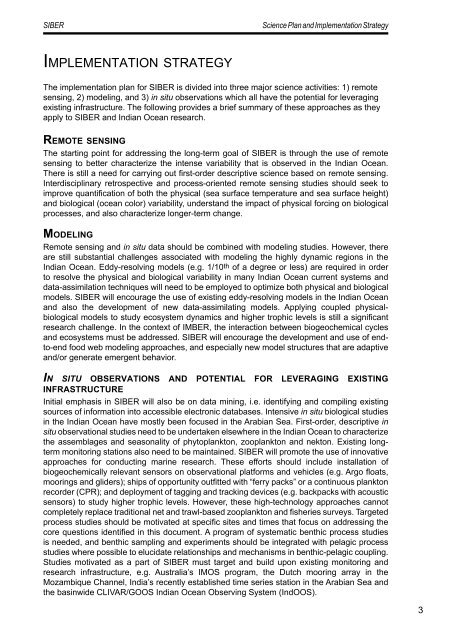SIBER SPIS sept 2011.pdf - IMBER
SIBER SPIS sept 2011.pdf - IMBER
SIBER SPIS sept 2011.pdf - IMBER
You also want an ePaper? Increase the reach of your titles
YUMPU automatically turns print PDFs into web optimized ePapers that Google loves.
<strong>SIBER</strong><br />
Science Plan and Implementation Strategy<br />
Im p l e m e n t a t i o n s t r a t e g y<br />
The implementation plan for <strong>SIBER</strong> is divided into three major science activities: 1) remote<br />
sensing, 2) modeling, and 3) in situ observations which all have the potential for leveraging<br />
existing infrastructure. The following provides a brief summary of these approaches as they<br />
apply to <strong>SIBER</strong> and Indian Ocean research.<br />
Rem o t e se n s i n g<br />
The starting point for addressing the long-term goal of <strong>SIBER</strong> is through the use of remote<br />
sensing to better characterize the intense variability that is observed in the Indian Ocean.<br />
There is still a need for carrying out first-order descriptive science based on remote sensing.<br />
Interdisciplinary retrospective and process-oriented remote sensing studies should seek to<br />
improve quantification of both the physical (sea surface temperature and sea surface height)<br />
and biological (ocean color) variability, understand the impact of physical forcing on biological<br />
processes, and also characterize longer-term change.<br />
Mod e l i n g<br />
Remote sensing and in situ data should be combined with modeling studies. However, there<br />
are still substantial challenges associated with modeling the highly dynamic regions in the<br />
Indian Ocean. Eddy-resolving models (e.g. 1/10th of a degree or less) are required in order<br />
to resolve the physical and biological variability in many Indian Ocean current systems and<br />
data-assimilation techniques will need to be employed to optimize both physical and biological<br />
models. <strong>SIBER</strong> will encourage the use of existing eddy-resolving models in the Indian Ocean<br />
and also the development of new data-assimilating models. Applying coupled physicalbiological<br />
models to study ecosystem dynamics and higher trophic levels is still a significant<br />
research challenge. In the context of <strong>IMBER</strong>, the interaction between biogeochemical cycles<br />
and ecosystems must be addressed. <strong>SIBER</strong> will encourage the development and use of endto-end<br />
food web modeling approaches, and especially new model structures that are adaptive<br />
and/or generate emergent behavior.<br />
In s i t u o b s e r v a t i o n s a n d p o t e n t i a l f o r l e v e r a g i n g e x i s t i n g<br />
i n f r a s t r u c t u r e<br />
Initial emphasis in <strong>SIBER</strong> will also be on data mining, i.e. identifying and compiling existing<br />
sources of information into accessible electronic databases. Intensive in situ biological studies<br />
in the Indian Ocean have mostly been focused in the Arabian Sea. First-order, descriptive in<br />
situ observational studies need to be undertaken elsewhere in the Indian Ocean to characterize<br />
the assemblages and seasonality of phytoplankton, zooplankton and nekton. Existing longterm<br />
monitoring stations also need to be maintained. <strong>SIBER</strong> will promote the use of innovative<br />
approaches for conducting marine research. These efforts should include installation of<br />
biogeochemically relevant sensors on observational platforms and vehicles (e.g. Argo floats,<br />
moorings and gliders); ships of opportunity outfitted with “ferry packs” or a continuous plankton<br />
recorder (CPR); and deployment of tagging and tracking devices (e.g. backpacks with acoustic<br />
sensors) to study higher trophic levels. However, these high-technology approaches cannot<br />
completely replace traditional net and trawl-based zooplankton and fisheries surveys. Targeted<br />
process studies should be motivated at specific sites and times that focus on addressing the<br />
core questions identified in this document. A program of systematic benthic process studies<br />
is needed, and benthic sampling and experiments should be integrated with pelagic process<br />
studies where possible to elucidate relationships and mechanisms in benthic-pelagic coupling.<br />
Studies motivated as a part of <strong>SIBER</strong> must target and build upon existing monitoring and<br />
research infrastructure, e.g. Australia’s IMOS program, the Dutch mooring array in the<br />
Mozambique Channel, India’s recently established time series station in the Arabian Sea and<br />
the basinwide CLIVAR/GOOS Indian Ocean Observing System (IndOOS).<br />
3












